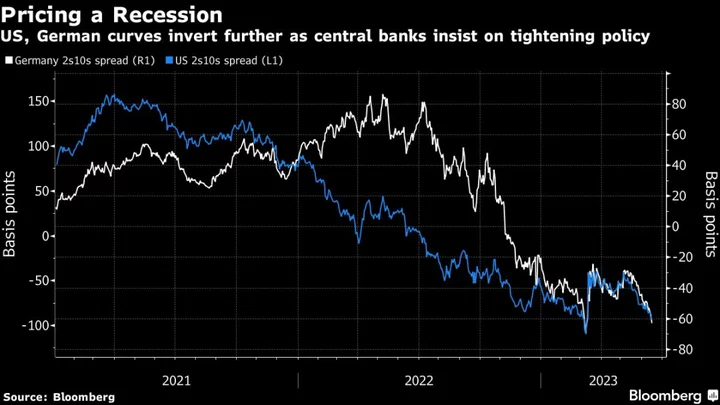Investor fears of mounting economic damage are threatening to overshadow the next round of interest-rate hiking all but promised by central bankers from Washington to Frankfurt.
With Federal Reserve Chair Jerome Powell flagging a potential further half-point in increases and his European Central Bank counterpart Christine Lagarde saying another quarter-point step is “very likely,” a pivotal week in the monetary calendar has left financial markets starting to count the cost that incessant tightening may inflict.
Signaling skepticism that policymakers can avoid a US recession, yields on US and German 10-year bonds are trading well below the rate on two-year securities. The Treasuries curve slightly deepened its inversion on Friday, near levels seen in early March, just before the US regional banking crisis roiled global markets. Two-year US yields rose four basis points to 4.68%, outpacing the 3 basis point advance in 10-year yields to 3.74%.
The danger perceived there is that central bankers’ zeal to stem the worst inflation in a generation will crush economies and force hurried policy reversals as consumer-price growth collapses.
The ECB knows that threat only too well, having twice this century aborted rate-hiking campaigns that are now perceived as policy errors. A reminder of the dangers came Thursday, when New Zealand — an early starter in global tightening — said output shrank in the fourth quarter of 2022 and again in the first of this year.
“Central banks collectively now seem to think that higher rates are still warranted even if their economies are softening or are already in recession,” said Charles Hepworth investment director at GAM Investments. “Policy mistakes could well be the unintended results.”
A renewed appetite for tightening has infected global central banks this month in the face of stubborn price pressures. Canada and Australia, whose yield curve on Thursday inverted for the first time since the financial crisis, both surprised investors last week by resuming tightening.
Wednesday’s Fed decision, while delivering on the pause that its officials had pledged, also offered investors an outlook of two further quarter-point hikes this year. One of those could come as soon as next month, which Powell described as a “live” meeting.
The ECB is “very likely” to follow suit with a step of its own the next day, Lagarde said Thursday — a week after data showed that she and her colleagues already hiked into a mild recession.
Given those comments, money-market traders see the Fed lifting the upper bound of its target rate to almost 5.5% — the highest since the turn of the century. For the ECB, they see even odds of a terminal rate of 4% by October — an all-time high.
“We believe risks to the terminal deposit rate of 3.75% are skewed to the upside,” said Anna Stupnytska, Global Macro Economist at Fidelity International.
But accompanying those bets are signs of market unease. A downward sloping, or inverted yield curve, is an anomaly. When long-term rates are lower than shorter-dated maturities it often suggest traders expect central banks will have to lower rates in the coming years, as a recession eventually bites and allows inflation to ease.
Powell said that Fed officials anticipate “subdued” expansion — though at a faster pace this year than previously expected — and that taming prices will require “below-trend growth and some softening of labor-market conditions.”
US data Thursday suggested the economy is holding up but losing steam. Retail sales last month exceeded nearly every estimate, but that report also showed consumer demand has moderated. Separately, factory production remained sluggish and applications for unemployment benefits held at the highest level since late 2021.
A surprise jump in the jobless rate last month “suggests a sea change may be under way,” according to David Wilcox of Bloomberg Economics, a former senior Fed official. “Still, it’s clear that a wide range of outcomes is plausible, from essentially no increase in unemployment — so-called “immaculate disinflation” — to a recession of moderate severity.”
The euro zone, meanwhile, is showing signs of sluggishness after a recession that lasted through the first quarter. The economy has “stagnated” and will remain weak in the short-run, according to Lagarde.
She acknowledged that prior hikes are transmitting “forcefully” into financing conditions and gradually throughout the economy, but cautioned that wage pressures are increasingly feeding inflation.
“The danger at this point is that by focusing on slow-moving, more lagging economic indicators, the ECB sleep-walks into an overtightening of policy,” said Joseph Little, Global Chief Strategist at HSBC Asset Management. “We may look back on these last few hikes of the tightening cycle as a ‘policy error.’”
--With assistance from Aline Oyamada, Alexander Weber and Jana Randow.
(Updates with Treasury moves in the third paragraph.)
Author: Craig Stirling, Alice Atkins and James Hirai

